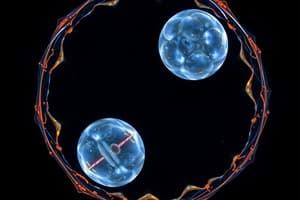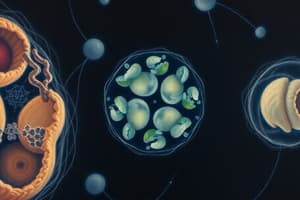Podcast
Questions and Answers
Meiosis II is very similar to mitosis in that sister chromatids rather than homologues are separated from each other.
Meiosis II is very similar to mitosis in that sister chromatids rather than homologues are separated from each other.
True (A)
Homologous chromosomes are identical copies of the same DNA that are held together at the centromere.
Homologous chromosomes are identical copies of the same DNA that are held together at the centromere.
False (B)
After meiosis I there are two haploid daughter cells, and after meiosis II there are up to four haploid gametes.
After meiosis I there are two haploid daughter cells, and after meiosis II there are up to four haploid gametes.
True (A)
Put the phases of mitosis in the correct order:
Put the phases of mitosis in the correct order:
Put the four stages of the cell cycle in the correct order:
Put the four stages of the cell cycle in the correct order:
What is the longest part of the cell cycle?
What is the longest part of the cell cycle?
What is the longest phase of mitosis?
What is the longest phase of mitosis?
What is the shortest phase of mitosis?
What is the shortest phase of mitosis?
What is the shortest phase of the cell cycle?
What is the shortest phase of the cell cycle?
Cells that do not actively divide spend all of their time in an offshoot of G2 called G0.
Cells that do not actively divide spend all of their time in an offshoot of G2 called G0.
Chromatin is the more condensed form of chromosomes.
Chromatin is the more condensed form of chromosomes.
Where are restriction points or checkpoints located in the cell cycle?
Where are restriction points or checkpoints located in the cell cycle?
During the S (synthesis) stage, the cell replicates its genetic material resulting in each chromosome consisting of two identical chromatids that are bound together at a specialized region known as the centromere.
During the S (synthesis) stage, the cell replicates its genetic material resulting in each chromosome consisting of two identical chromatids that are bound together at a specialized region known as the centromere.
Mitosis occurs in germ cells, or cells that are involved in sexual reproduction.
Mitosis occurs in germ cells, or cells that are involved in sexual reproduction.
Meiosis occurs in gametocytes (germ cells) and results in up to two nonidentical sex cells (gametes).
Meiosis occurs in gametocytes (germ cells) and results in up to two nonidentical sex cells (gametes).
Is Meiosis I or Meiosis II similar to mitosis?
Is Meiosis I or Meiosis II similar to mitosis?
During prophase, the chromosomes uncoil and the spindle forms.
During prophase, the chromosomes uncoil and the spindle forms.
In which phase of mitosis do the kinetochore fibers interact with the fibers of the spindle apparatus to align the chromosomes equidistant between the two poles of the cell?
In which phase of mitosis do the kinetochore fibers interact with the fibers of the spindle apparatus to align the chromosomes equidistant between the two poles of the cell?
In which phase of mitosis does the spindle apparatus disappear?
In which phase of mitosis does the spindle apparatus disappear?
In which phase of mitosis does the spindle apparatus form?
In which phase of mitosis does the spindle apparatus form?
During which phase of mitosis do kinetochores appear at the centromere?
During which phase of mitosis do kinetochores appear at the centromere?
In which phase of mitosis do the centromeres split so that each chromatid has its own distinct centromere?
In which phase of mitosis do the centromeres split so that each chromatid has its own distinct centromere?
During which phase of mitosis do some microtubules form asters that anchor the centrioles to the cell membrane?
During which phase of mitosis do some microtubules form asters that anchor the centrioles to the cell membrane?
During which phase of mitosis does the nuclear membrane reform around each set of chromosomes, and the nucleoli reappear?
During which phase of mitosis does the nuclear membrane reform around each set of chromosomes, and the nucleoli reappear?
During which phase of mitosis does the nuclear membrane dissolve, allowing the spindle fibers to contact the chromosomes?
During which phase of mitosis does the nuclear membrane dissolve, allowing the spindle fibers to contact the chromosomes?
During which phase of mitosis are sister chromatids pulled toward the opposite poles of the cell by shortening of the kinetochore fibers?
During which phase of mitosis are sister chromatids pulled toward the opposite poles of the cell by shortening of the kinetochore fibers?
During which phase of mitosis do the centriole pairs separate and move toward opposite poles?
During which phase of mitosis do the centriole pairs separate and move toward opposite poles?
During which phase of mitosis does the separation of the cytoplasm and organelles occur so that each daughter cell has sufficient supplies to survive on its own?
During which phase of mitosis does the separation of the cytoplasm and organelles occur so that each daughter cell has sufficient supplies to survive on its own?
During which phase of mitosis does the nucleoli become less distinct, and may disappear completely?
During which phase of mitosis does the nucleoli become less distinct, and may disappear completely?
The completion of mitosis results in two identical daughter cells.
The completion of mitosis results in two identical daughter cells.
What are spindle fibers made of?
What are spindle fibers made of?
During cytokinesis of mitosis, what is the cleavage furrow formed from?
During cytokinesis of mitosis, what is the cleavage furrow formed from?
What are centrioles made of?
What are centrioles made of?
There is no change in ploidy during meiosis.
There is no change in ploidy during meiosis.
After S phase, there are 92 chromatids organized into 46 chromosomes, which are organized into 23 homologous pairs.
After S phase, there are 92 chromatids organized into 46 chromosomes, which are organized into 23 homologous pairs.
At which phase of meiosis do homologous chromosomes come together and intertwine in a process called synapsis?
At which phase of meiosis do homologous chromosomes come together and intertwine in a process called synapsis?
At which phase of meiosis do the homologous pair separate and are pulled to opposite poles of the cell in a process called disjunction?
At which phase of meiosis do the homologous pair separate and are pulled to opposite poles of the cell in a process called disjunction?
During which meiosis phase do homologous pairs (tetrads) align at the metaphase plate, and each pair attaches to a separate spindle fiber by its kinetochore?
During which meiosis phase do homologous pairs (tetrads) align at the metaphase plate, and each pair attaches to a separate spindle fiber by its kinetochore?
At which phase in meiosis can nondisjunction occur?
At which phase in meiosis can nondisjunction occur?
During which phase of meiosis do the cells become haploid and divide into two daughter cells by cytokinesis?
During which phase of meiosis do the cells become haploid and divide into two daughter cells by cytokinesis?
At which phase of meiosis does crossing over occur?
At which phase of meiosis does crossing over occur?
The further apart two genes are, the more likely they are to become unlinked during crossing over.
The further apart two genes are, the more likely they are to become unlinked during crossing over.
Flashcards are hidden until you start studying
Study Notes
Cell Cycle and its Phases
- The cell cycle consists of four main stages: G1, S, G2, and M (mitosis).
- Interphase includes G1, S, and G2 phases, during which the cell prepares for division.
- Interphase is the longest part of the cell cycle, with cells spending about 90% of their time in this phase.
Mitosis Overview
- Mitosis comprises several phases: Prophase, Metaphase, Anaphase, and Telophase (PMAT).
- Prophase is the longest phase of mitosis, involving chromosome condensation and spindle formation.
- Anaphase is the shortest phase, characterized by the pulling apart of sister chromatids.
Mitosis vs. Meiosis
- Mitosis occurs in somatic cells, resulting in two identical daughter cells; meiosis occurs in germ cells, yielding four nonidentical gametes.
- Meiosis involves two rounds of division (Meiosis I and II) following one round of DNA replication, leading to the halving of chromosome number.
Meiosis Phases
- Meiosis I: Homologous chromosomes separate (reductional division) resulting in haploid cells.
- Meiosis II: Similar to mitosis, sister chromatids separate (equational division) without changing ploidy.
Genetic Processes in Meiosis
- Synapsis occurs in Prophase I, where homologous chromosomes intertwine, forming tetrads.
- Crossing over occurs during Prophase I, where segments of chromatids are exchanged, increasing genetic variability.
- Disjunction happens in Anaphase I, where homologous chromosomes are pulled to opposite poles.
Key Functions and Structures
- Kinetochore fibers interact with spindle fibers to align chromosomes during Metaphase.
- Centrioles are structures that organize microtubules, crucial for spindle formation during cell division.
- Microtubules form spindle fibers, while microfilaments aid in cytokinesis by forming a cleavage furrow.
Chromatin and Chromosomes
- Chromatin is the less condensed form of DNA during interphase, allowing accessibility for transcription.
- Chromosomes become highly condensed during mitosis, enabling equal separation during cell division.
Checkpoints and Regulation
- Checkpoints occur in G1/S and G2/M phases, ensuring DNA integrity before proceeding to synthesis and mitosis.
- Protein p53 plays a critical role in detecting DNA damage, halting the cell cycle if necessary.
Importance of Cytokinesis
- Cytokinesis separates the cytoplasm and organelles into two distinct daughter cells post-mitosis.
- During cytokinesis in meiosis, up to four haploid daughter cells are produced from one gametocyte.
Genetic Linkage and Variation
- Genes that are physically farther apart on a chromosome are more likely to recombine during crossing over.
- Gene linkage affects inheritance patterns, where genes close together tend to be inherited together, while distant genes have higher chances of being separated.
Ploidy Changes
- After S phase, cells contain 92 chromatids organized into 46 chromosomes, forming 23 homologous pairs.
- Meiosis I results in haploid cells (n), while Meiosis II maintains the haploid state by separating sister chromatids.
Studying That Suits You
Use AI to generate personalized quizzes and flashcards to suit your learning preferences.




